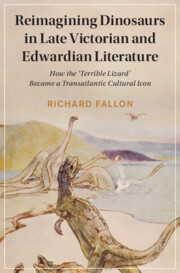 Reimagining Dinosaurs in Late Victorian and Edwardian Literature
Reimagining Dinosaurs in Late Victorian and Edwardian Literature Book contents
- Reimagining Dinosaurs in Late Victorian and Edwardian Literature
- Cambridge Studies in Nineteenth-Century Literature and Culture
- Reimagining Dinosaurs in Late Victorian and Edwardian Literature
- Copyright page
- Contents
- Figures
- Acknowledgements
- Note on Scientific Terminology
- Introduction Dinosaurs in Transition
- Chapter 1 Reclaiming Authority: Henry Neville Hutchinson, Popular Science, and the Construction of the Dinosaur
- Chapter 2 Reinventing Wonderland: Jabberwocks, Grotesque Monsters, and Dinosaurian Maladaptation
- Chapter 3 Rearticulating the Nation: Transatlantic Fiction and the Dinosaurs of Empire
- Chapter 4 Rediscovering Lost Worlds: Arthur Conan Doyle and the Modern Romance of Palaeontology
- Conclusion Dinosaurs Rewritten
- Notes
- Bibliography
- Index
- CAMBRIDGE STUDIES IN NINETEENTH-CENTURY LITERATURE AND CULTURE
Chapter 4 - Rediscovering Lost Worlds: Arthur Conan Doyle and the Modern Romance of Palaeontology
Published online by Cambridge University Press: 28 October 2021
- Reimagining Dinosaurs in Late Victorian and Edwardian Literature
- Cambridge Studies in Nineteenth-Century Literature and Culture
- Reimagining Dinosaurs in Late Victorian and Edwardian Literature
- Copyright page
- Contents
- Figures
- Acknowledgements
- Note on Scientific Terminology
- Introduction Dinosaurs in Transition
- Chapter 1 Reclaiming Authority: Henry Neville Hutchinson, Popular Science, and the Construction of the Dinosaur
- Chapter 2 Reinventing Wonderland: Jabberwocks, Grotesque Monsters, and Dinosaurian Maladaptation
- Chapter 3 Rearticulating the Nation: Transatlantic Fiction and the Dinosaurs of Empire
- Chapter 4 Rediscovering Lost Worlds: Arthur Conan Doyle and the Modern Romance of Palaeontology
- Conclusion Dinosaurs Rewritten
- Notes
- Bibliography
- Index
- CAMBRIDGE STUDIES IN NINETEENTH-CENTURY LITERATURE AND CULTURE
Summary
Chapter 4 shows dinosaurs’ link to concerns about secularisation and specialisation contributed to Arthur Conan Doyle’s famous romance The Lost World. It argues that the text can be understood in relation to Conan Doyle’s romantic approach to scientific knowledge, especially his strident anti-materialism and aversion to technical jargon. Examining archival material from New York Public Library’s Berg Collection, including the original manuscript, Fallon weaves the content of The Lost World together in surprising ways with Conan Doyle’s palaeontological forays, cryptozoological sightings, and interest in psychical research, showing that noting the differences between the US and UK serialised and book versions provides a more precise understanding of Conan Doyle’s intended romantic effects. In particular, Fallon emphasises the illustrations by Conan Doyle’s brother-in-law, Patrick Forbes. Alongside the text, these subtle and meticulously planned images make clear the author’s desire to convince readers that the world is full of unexplained wonders. As such, the British book edition in which Forbes’s images appear was, for Conan Doyle, the correct way to experience The Lost World.
Keywords
- Type
- Chapter
- Information
- Reimagining Dinosaurs in Late Victorian and Edwardian LiteratureHow the ‘Terrible Lizard' Became a Transatlantic Cultural Icon, pp. 136 - 173Publisher: Cambridge University PressPrint publication year: 2021


